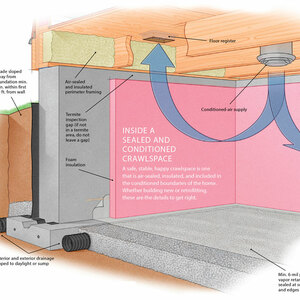I have recently purchased a home with plaster walls. This will be my first experience dealing with plaster. So, I have a concern that if I nail into the plaster the nail might crack the walls, or that the nail will not go in all the well. I do have the nail guns for the project available to me. Am I concerned for no reason? or are there certain tricks to avoid any problems? I have about two weeks until i close on the home. Thanks for any advice that you may have.
Mark


















Replies
Plaster walls shouldn't present any problems for nailing. The problems will come when you get to the corners and find that every one is out of square. Mesure twice cut several times, have fun.
If you're nailing or screwing something into the wall, try putting a strip of adhesive tape there, it'll make it easier to remove the screw or nail later.
Not to make things more confusing (for a change) but you may wanna look into making your own crown out of plaster....isnt that hard really and looks awesome.
I learned to do it out of necessity in my early years of reno work.
HAd to take down some walls and continue the crown.
MAde a spackle knife out of metal.
Drew the profile of the existing crown on the metal....cut it out...added a handle of 1x.
MAde a sort of L shaped trough(sp?) with a guide on top and bottom....8' long and dumped plaster in it and kept running my knife in there till it was perfect...then sanded it a bit..
One hint is to use a tad of vinager or milk to slow the process down.
I then broke out the area it was going in and plastered it in.
Be well
a,,,
The secret of Zen in two words is, "Not always so"!
When we meet, we say, Namaste'..it means..
http://CLIFFORDRENOVATIONS.COM
Suggest using square head finish screws instead. Screws cause less damage to plaster, and can also be removed with minimal damage if a mistake is made.
Or, you can back the whole thing up with trim boards. With a moulded edge, they add depth, and help take care of any wavyness.
Or you can use triangular blocking for support.
Take the time to put in crown backer blocks. Rip them with a bevel that matches the spring angle of the crown. Make the blocking just slightly smaller than the void that exists behind the crown once it is intalled. Install the backer with screws into the studs and/or ceiling joists. Don't run the backer all the way into the corners, rather let it stop several inches shy of each corner. Now you can install the crown by airnailing into the backer. Don't use a hammer! It will only loosen the plaster keys behind the lath, cause cracking etc. Unless you are very lucky the corners won't be square so coping cuts are a must. Trial and error, with a good block plane and rasps. If its paint grade you get a little wiggle room with caulk although some of the anal perfectionists frown on this.
Thank you all for your input. It will take me a few weeks to actually get to try any of the techniques out. But I am from the school of trial and error, so I will try a few. I like the idea of making plaster crown. I may try it in one of the smaller rooms of which there are only 4.
Thanks again,
Mark
Mark, do as Ripmaster says, install blocking first.
mike
and remember .. you only need the blocking on 2 of the 4 walls ...
the walls where the joists run parallel.
the other two ... where the joists run perp .... you'll find some meat every 16OC or so.
Jeff Buck Construction
Artistry in Carpentry
Pgh, PA
thats true, but i still prefer to run the entire perimeter. Then I don't have to think about where to shoot the finish nails into the crown. I've found too that unless your ceilings are perfectly flat the ability to shoot a strategically placed nail anywhere along the run allows you to tweak the crown to the ceiling thereby minimizing any scribing or gaps.